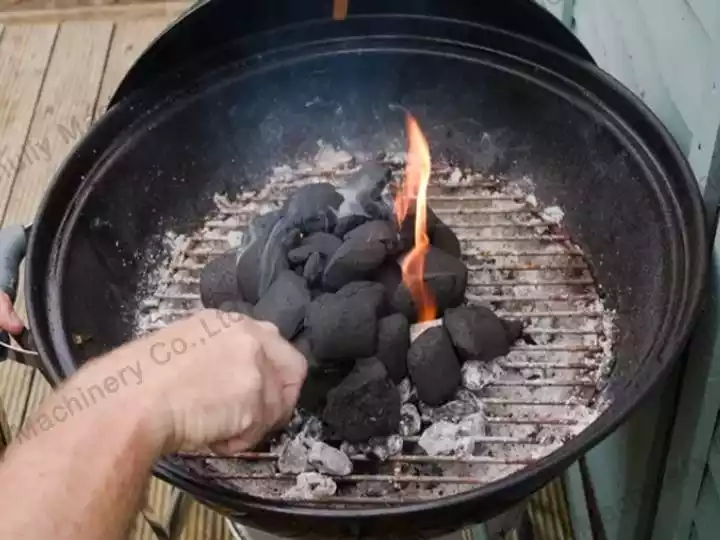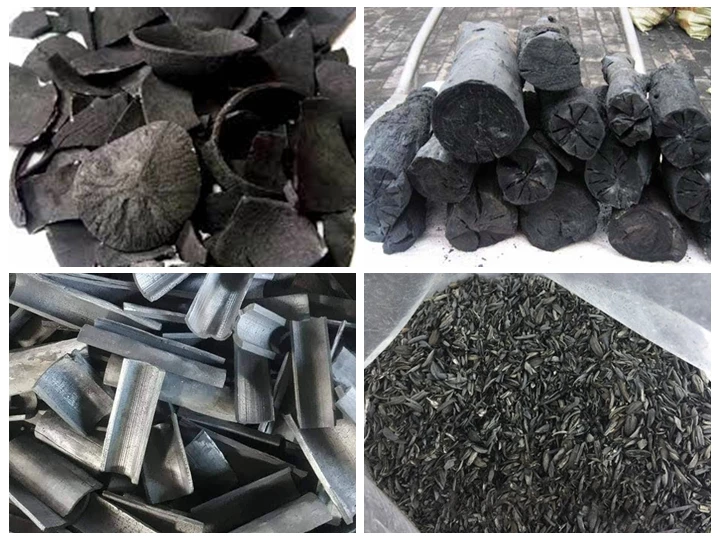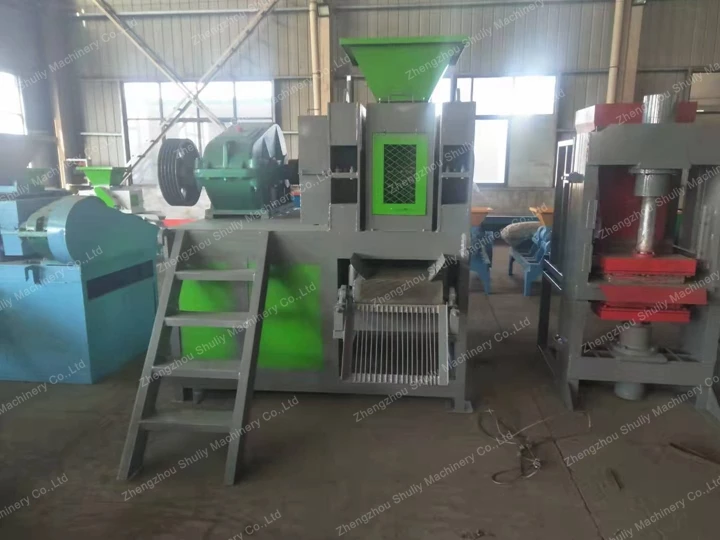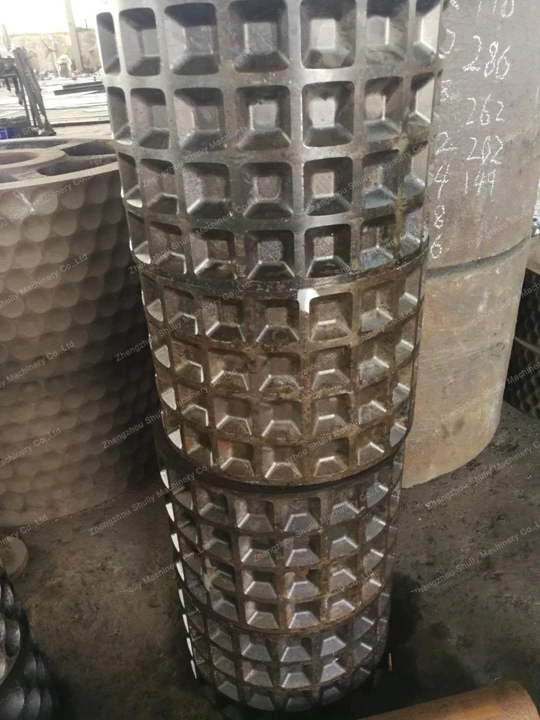バーベキュー用木炭の作り方
バーベキュー炭、別名バーベキュー用炭は、グリルやバーベキュー料理に特化した炭の一種です。その人気は、一貫した長時間の熱を提供できる能力に由来し、屋外調理に理想的な選択肢となっています。バーベキュー愛好家やバーベキュー炭の販売業者であっても、バーベキュー炭の加工過程には興味があるでしょう。この記事では、バーベキュー炭の原料、加工工程、必要な設備や工具など、詳細な情報を説明します。
バーベキュー炭の作り方のステップ
どのようにバーベキュー炭を加工したい場合でも、まず原料としてバーベキュー炭粉、つまり炭粉または炭の粉末を入手する必要があります。原料が塊炭の場合は、クラッシャーを使用して塊炭を粉砕することをお勧めします。細かい炭粉は、高品質なバーベキュー用ブリケットの加工に不可欠です。

炭粉(炭の粉末)を用いたバーベキュー炭の加工は、炭粉やその他の原料を高品質なバーベキュー炭製品に変える効果的な方法です。
バーベキュー炭作りの一般的な手順
ステップ1:原材料の準備
炭粉:炭粉を十分な量集めます。炭粉は木炭や他の炭粉(通常は木や植物の残渣)です。
結合剤:デンプン、コーンスターチ、小麦粉、または他のバインダーは、炭粉の形状を保持するのに役立ちます。
添加剤(オプション):スパイスや燻製木片を加えることで、バーベキュー炭に異なる風味を与えることができます。
ステップ2:炭粉の混合
炭粉と結合剤を均一に分散させるように混合します。これは通常、ミキサーやブレンダーを必要とします。
ステップ3:成形
バーベキュー炭成形機やバーベキュー炭機械を使用して、混合した原料を球体、枕型、正方形、またはその他のカスタム形状に成形します。
ステップ4:乾燥
成形したバーベキュー炭を換気の良い場所に置くか、乾燥設備を使用して余分な水分を除去し、炭を硬くして点火しやすくします。
ステップ5:梱包
バーベキュー炭が完全に乾燥したら、炭球包装機を使用して適切なパッケージ(通常は袋や箱)に梱包します。パッケージは炭の品質と水分含有量を維持するようにしてください。
ステップ6:品質管理
品質管理試験を実施し、炭が密度、燃焼時間、温度などの必要な品質基準を満たしていることを確認します。
ステップ7:分配
加工されたバーベキュー炭は、スーパーマーケット、バーベキュー用品店、レストランなどに流通し、顧客が購入して使用します。
どの種類の炭がバーベキュー用炭の加工に適していますか?
適切な炭素材を選ぶ際には、熱生成、燃焼時間、煙の風味、入手性を考慮することが重要です。さまざまな種類の炭は、異なるバーベキューのニーズに適しています。最良のバーベキュー炭は通常、純粋で添加物や化学物質を含まないため、食品の安全性と風味を確保します。

バーベキュー炭を作る際に、通常次の種類の炭を原料として選びます:
- 木炭:木炭は高温と長時間の燃焼を提供できるため、バーベキュー用炭の最も一般的な原料の一つです。一般的な木材にはオーク、メープル、バスウッド、果樹(リンゴ、サクランボ、マホガニーなど)があります。これらの木は通常、優れた風味の焼き食品を生み出します。
- ココナッツシェル炭:ココナッツシェル炭も人気の選択肢です。ココナッツシェルから得られ、軽いスモーキーな風味があり、一定の高温と長時間の燃焼を提供します。ココナッツ炭は、再生可能なココナッツシェルを原料としているため、環境に優しいと考えられています。
- 竹炭:竹炭は比較的新しいが、ますます人気のある選択肢です。竹から作られ、高温で処理されて作られます。竹炭は安定した温度と燃焼を提供し、多くの環境に優しい特徴もあります。
- 硬木炭:硬木炭はオーク、ブナ、メープルなどの硬木から作られます。これらの木からの炭は通常、より硬く高温で、長時間のバーベキューに適しています。
- 草本炭:一部のバーベキュー用炭はハーブやわら、しばしばデンプンなどの結合剤を加えて形を保ちます。このタイプの炭は通常、短時間のバーベキューに適しています。
バーベキュー炭の製造に推奨される設備
バーベキュー炭の製造ビジネスに従事したいお客様には、一連のバーベキュー炭機械が不可欠です。長年にわたり炭素設備の製造と輸出に従事してきたShuliy工場は、いくつかの実用的な設備をお勧めします。
炭の原料がない場合は、炭窯を建てるか、炭化炉を購入してさまざまな原料を炭に変えることができます。炭を持っている場合は、自分のニーズに応じてバーベキュー炭の加工設備が必要かどうかを判断できます。
- 炭粉砕機:炭粉砕機は、炭化した塊炭を所望の粒径に粉砕するために使用されます。これにより、一貫したバーベキュー炭を生産できます。
- 混合機:混合機は、炭粉とバインダーを混合して成形に適した混合物を作るために使用されます。
- ブリケット機:ブリケット機は炭粉とバインダーを圧縮して、バーベキュー用炭の希望の形にします。
- 乾燥機:乾燥機は、バーベキュー炭から水分を除去し、貯蔵や使用中の安定性を確保します。



コメントなし